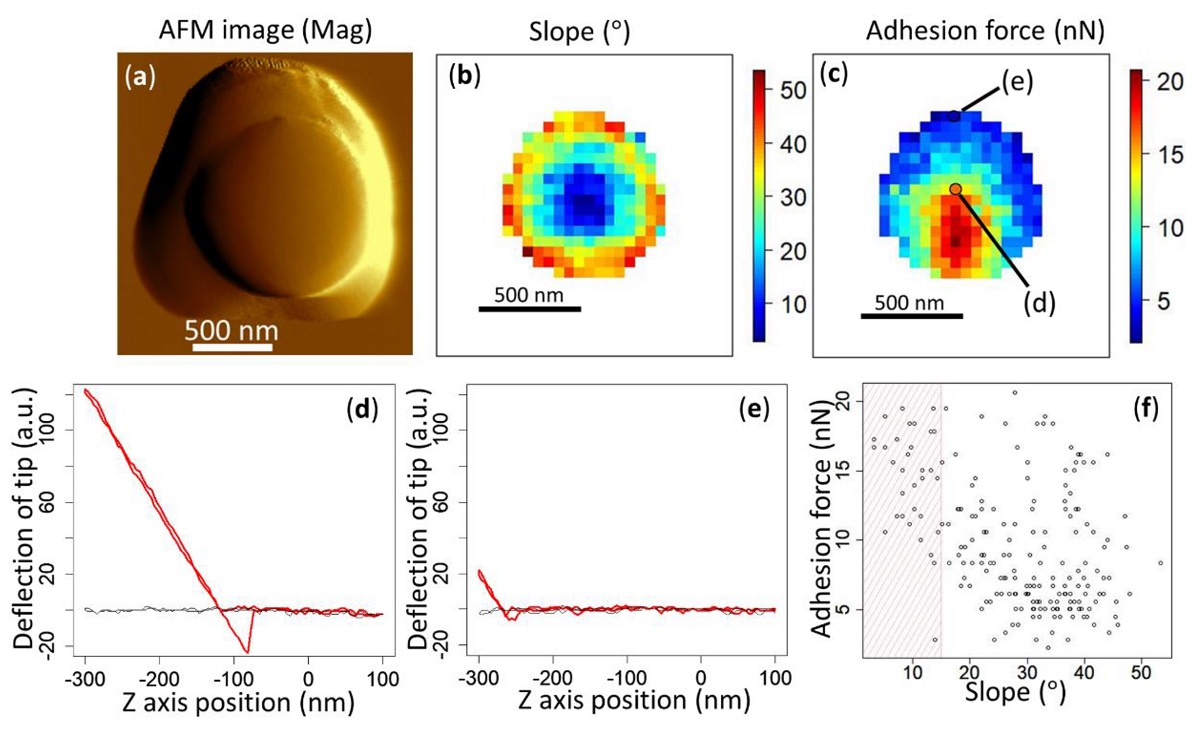In the article «Direct Measurement of Adhesion Force of Individual Aerosol Particles by Atomic Force Microscopy» Kohei Ono, Yuki Mizushima, Masaki Furuya, Ryota Kunihisa, Nozomu Tsuchiya, Takeshi Fukuma, Ayumi Iwata and Atsushi Matsuki describe a new method, namely, force–distance curve mapping, that was developed to directly measure the adhesion force of individual aerosol particles by atomic force microscopy.*
The proposed method collects adhesion force from multiple points on a single particle. It also takes into account the spatial distribution of the adhesion force affected by topography (e.g., the variation in the tip angle relative to the surface, as well as the force imposed upon contact), thereby enabling the direct and quantitative measurement of the adhesion force representing each particle.*
The results presented in the article highlight that the original chemical composition, as well as the aging process in the atmosphere, can create significant variation in the adhesion force among individual particles. This study demonstrates that force–distance curve mapping can be used as a new tool to quantitatively characterize the physical properties of aerosol particles on an individual basis.*
The measurement of adhesion force described in the article was performed in contact mode using silicon NANOSENSORS™ AdvancedTEC™ ATEC-CONT AFM tips.*

Atomic force microscopy (AFM) mag image (a), slope mapping (b), and adhesion force mapping (c) obtained from the same 1 μm PSL particle. Representative force–distance curves are shown for the point at which the tip is properly in contact with the surface with sufficient stroke (loading force), at the proper angle (d) and for the point further towards the edge where the tip is barely touching the surface at a steep angle (e). The black lines in panels (d) and (e) show the baseline in which the tip did not touch the particle or substrate. A plot of the relationship between the slope and the adhesion force is shown in panel (f). The plots in the shaded area are considered to represent the adhesion force of the particle.
*Kohei Ono, Yuki Mizushima, Masaki Furuya, Ryota Kunihisa, Nozomu Tsuchiya,Takeshi Fukuma, Ayumi Iwata and Atsushi Matsuki
Direct Measurement of Adhesion Force of Individual Aerosol Particles by Atomic Force Microscopy
Atmosphere 2020, 11(5), 489
DOI: https://doi.org/10.3390/atmos11050489
Please follow this external link to read the full article: https://www.mdpi.com/2073-4433/11/5/489/htm
Open Access: The article “Direct Measurement of Adhesion Force of Individual Aerosol Particles by Atomic Force Microscopy” by Kohei Ono, Yuki Mizushima, Masaki Furuya, Ryota Kunihisa, Nozomu Tsuchiya,Takeshi Fukuma, Ayumi Iwata and Atsushi Matsuki is licensed under a Creative Commons Attribution 4.0 International License, which permits use, sharing, adaptation, distribution and reproduction in any medium or format, as long as you give appropriate credit to the original author(s) and the source, provide a link to the Creative Commons license, and indicate if changes were made. The images or other third party material in this article are included in the article’s Creative Commons license, unless indicated otherwise in a credit line to the material. If material is not included in the article’s Creative Commons license and your intended use is not permitted by statutory regulation or exceeds the permitted use, you will need to obtain permission directly from the copyright holder. To view a copy of this license, visit http://creativecommons.org/licenses/by/4.0/.